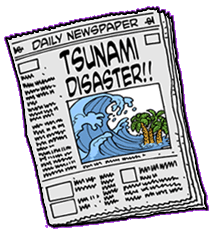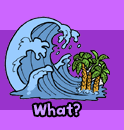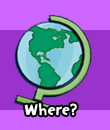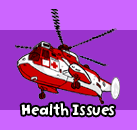


Tsunamis are giant sea waves. They can be caused by an (1) earthquake that occurs under an ocean, (2) by an underwater landslide, or (3) when a volcano erupts under water. Unlike the regular waves you might see at the beach or during a normal storm, tsunamis don't form on the surface of the water. They build energy as they move water within the ocean, sometimes as much as several miles deep!
Deep in the ocean, a tsunami's waves may only be a foot high. Since they can move at 300-600 miles an hour, by the time the waves reach the shallow water near the shore of islands or countries, the pent-up energy can make the wave(s) be as high as 80 feet tall. When it hits land, the waves' force will destroy anything in their way.

During a normal storm or hurricane, the combination of strong winds and low pressure weather systems can cause the ocean's water to build up and quickly rush ashore. This is called a storm surge and can be dangerous because of heavy flood waters.
However, a tsunami is even more powerful! Once a tsunami occurs in the middle of the ocean, it can travel thousands of miles at 300-600 miles an hour without losing much energy. When all that force hits the land, it hits it hard! And it's not just one wave. In fact, more waves can arrive every 10 to 45 minutes, so the destruction can continue for several hours.
But tsunamis aren't always destructive. For example, Hawaii's coasts were evacuated in 1986 after a tsunami warning was issued. When it finally hit the shore, the wave was less than a foot tall and didn't cause any damage.


One sign of a tsunami is when the water level along coastlines changes (either by rising or falling) rapidly. In countries that don't have warning systems for tsunamis, the first thing people might see are stronger waves like the ones in an ordinary storm. These are followed quickly by the big tsunami waves.
The United States has warning systems in place to help protect people in Hawaii and on the West Coast, where tsunamis can hit. Scientists and researchers monitor for signs of a tsunami (like an underwater earthquake). If they notice something, they notify organizations to warn people through TV and radio announcements and with warning sirens.

In the United States, Alaska, Hawaii, and the coasts of Washington, Oregon and California are most at risk. In fact, tsunamis hit Hawaii about once a year. Most aren't dangerous. In fact, damaging tsunamis only hit about once every seven years.

 |
 |
 |
 |
 |